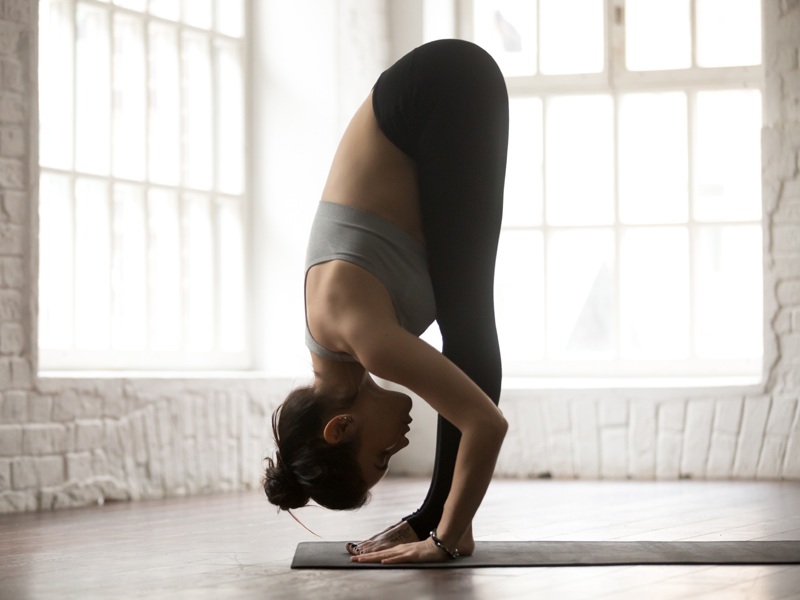

Uttana word means to elongate, intense stretch and forward extension, in this posture whole rear body is stretched from bottom of the feet all the way up to crown of the head, spine is in forward fold position and hip is hinged to its max that let the head remain below heart which makes this posture half inversion leading towards heavy blood circulation towards head.
Uttanasana (Standing Forward Bend) Step by step instructions:
- Start from tadasana or samasathiti as a starting position where you stand tall keeping whole body in straight line and aligned position
- Raise your hands up as you inhale and elongate your spine to create a good space for forward bend.
- With exhalation reach your hands forward and all the way down on the floor beside or behind the heels flat while the shoulders are trying to press against the knees and forehead in trying to move between shin bones.
- Legs will remain significantly straight and spine will be in forward bend as if in cat pose in table top position which allows abdominal muscles to engage and creates a healthy movement for spine.
Uttanasana (Standing Forward Bend) Benefits:
- Uttanasana is best position for a beginner to do as an inversion because it encourages good amount of blood and oxygen supply to brain.
- People with thigh and belly fat must practice this posture to get rid of it.
- Uttanasana is helpful for aiding digestive process as it stimulates the internal organs.
- People with diabetes should also include this posture especially the cat position from Utanasana could help stimulate pancreas.
- For flexibility in back of the thighs (hamstrings), calves and spine it is one of the recommended poses.
Uttanasana (Standing Forward Bend) Precautions and Safety:
- While you bend forward from standing position to keep your spine safe and stretch your back of the thighs gently bend the knees slightly it will allow hip to hinge well and spine will be in an elongated position.
- Being a beginner better trying to keep the spine almost in straight shape to avoid lower back pain.
- Focus on pushing forward and down instead of backwards to the legs.
- When your legs are flexible enough to be kept straight try to round Your spine like in cat pose to engage core and avoid lower back compression.
- People with high or low blood pressure should transition in and out very gently.
- People with sciatica should keep a block under the heels, bend the knees and keep the chin lifted up slightly.
- If one has lower back pain one should keep the navel in gently and support the hands-on block or floor properly so weight doesn’t fall upon the lowetback.
Recent Posts
- Yoga for Beginners at Home
- Chair Yoga for Seniors
- Sun Piercing Breath (Surya Bhedi Pranayama)
- Do You Need to Be Flexible to Start Yoga?
- Swooning Breath Yoga (Murcha Pranayama)
- Cooling Breath (Sheetali Pranayama)
- Sheetkari Pranayama: Feel The Calm In Daily Yoga
- Yoga for Every Body: A Beginner’s Guide to Wellness
- An Expert’s Guide to Yoga Philosophy
- What is Yin Yoga? 10 Benefits of Yin Yoga
- The Subtle Energy centres of the human body
- Emotional Healing through Yin Yoga
- Philosophy of action – Karma Yoga
- Yoga for Adolescent Girls
- Pranayama- the Ashta Kumbhakas
- Key Muscles Used in Ashtanga Primary Series
- Spine Health And Yoga: Top 5 Yoga Poses for a Healthy Spine and Back
- Scorpion Pose for Strength and Flexibility: An Ultimate Guide for Mastering the Balancing Act
- Why Multi-Style Yoga Training is the Ultimate Choice for Aspiring Instructors
- How Yoga Science and Anatomy Enhance The Practice


